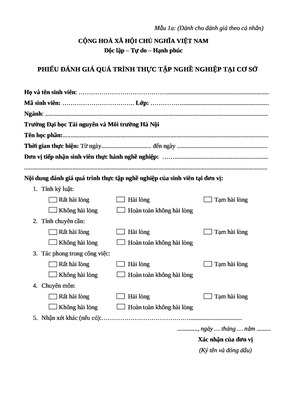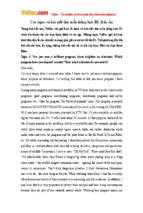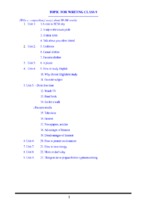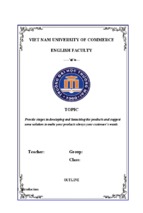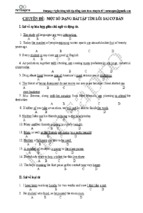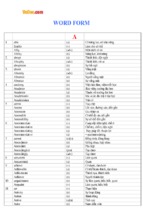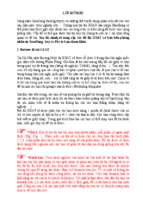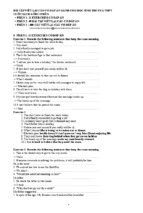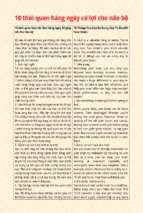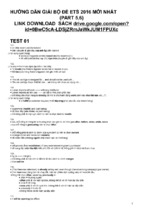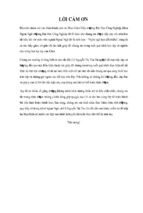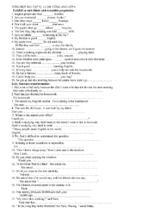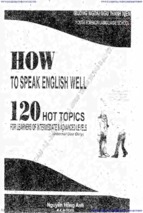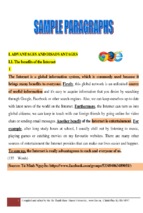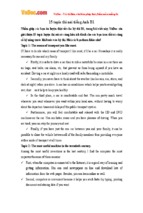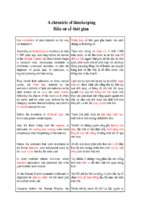This page intentionally left blank
An Introduction to English Sentence Structure
This outstanding resource for students offers a step-by-step, practical
introduction to English syntax and syntactic principles, as developed by
Chomsky over the past 15 years. Assuming little or no prior background
in syntax, Andrew Radford outlines the core concepts and how they can
be used to describe various aspects of English sentence structure. This is
an abridged version of Radford’s major new textbook Analysing English
Sentences (also published by Cambridge University Press), and will be
welcomed as a handy introduction to current syntactic theory.
andrew radford is Professor & Head of the Department of Language
and Linguistics at the University of Essex. His recent publications include
Minimalist Syntax: Exploring the Structure of English (Cambridge, 2004)
and English Syntax: An Introduction (Cambridge, 2004).
An Introduction to English
Sentence Structure
●
ANDREW RADFORD
University of Essex
CAMBRIDGE UNIVERSITY PRESS
Cambridge, New York, Melbourne, Madrid, Cape Town, Singapore, São Paulo
Cambridge University Press
The Edinburgh Building, Cambridge CB2 8RU, UK
Published in the United States of America by Cambridge University Press, New York
www.cambridge.org
Information on this title: www.cambridge.org/9780521516938
© Andrew Radford 2009
This publication is in copyright. Subject to statutory exception and to the
provision of relevant collective licensing agreements, no reproduction of any part
may take place without the written permission of Cambridge University Press.
First published in print format 2009
ISBN-13
978-0-511-50666-6
eBook (EBL)
ISBN-13
978-0-521-51693-8
hardback
ISBN-13
978-0-521-73190-4
paperback
Cambridge University Press has no responsibility for the persistence or accuracy
of urls for external or third-party internet websites referred to in this publication,
and does not guarantee that any content on such websites is, or will remain,
accurate or appropriate.
Contents
Preface
1 Grammar
1.1
1.2
1.3
1.4
1.5
1.6
1.7
1.8
1.9
Overview
Traditional grammar: Categories and functions
Universal Grammar
The Language Faculty
Principles of Universal Grammar
Parameters
Parameter-setting
Summary
Bibliographical background
Workbook section
2 Structure
2.1
2.2
2.3
2.4
2.5
2.6
2.7
2.8
2.9
2.10
Overview
Phrases
Clauses
Clauses containing complementisers
Testing structure
Structural relations and the syntax of polarity items
The c-command condition on binding
Bare phrase structure
Summary
Bibliographical background
Workbook section
3 Null constituents
3.1
3.2
3.3
3.4
3.5
3.6
3.7
3.8
3.9
3.10
Overview
Null subjects
Null auxiliaries
Null T in finite clauses
Null T in infinitive clauses
Null C in finite clauses
Null C in infinitive clauses
Defective clauses
Null determiners and quantifiers
Summary
page viii
1
1
1
11
15
19
22
26
30
32
33
39
39
39
44
49
51
58
62
64
66
69
70
81
81
81
86
89
94
96
101
105
108
111
v
vi
contents
3.11
Bibliographical background
Workbook section
4 Head movement
4.1
4.2
4.3
4.4
4.5
4.6
4.7
4.8
4.9
4.10
Overview
T-to-C movement
Movement as copying and deletion
V-to-T movement
Head movement
Auxiliary Raising
Another look at negation
do -support
Summary
Bibliographical background
Workbook section
5 Wh-movement
5.1
5.2
5.3
5.4
5.5
5.6
5.7
5.8
5.9
5.10
Overview
Wh-questions
Wh-movement as copying and deletion
Driving wh-movement and auxiliary inversion
Pied-piping of material in the domain of a wh-word
Pied-piping of a superordinate preposition
Long-distance wh-movement
Multiple wh-questions
Summary
Bibliographical background
Workbook section
6 A-movement
6.1
6.2
6.3
6.4
6.5
6.6
6.7
6.8
6.9
6.10
6.11
Overview
Subjects in Belfast English
Idioms
Argument structure and theta-roles
Unaccusative predicates
Passive predicates
Long-distance passivisation
Raising
Comparing raising and control predicates
Summary
Bibliographical background
Workbook section
7 Agreement, case and A-movement
7.1
7.2
7.3
7.4
Overview
Agreement
Feature Valuation
Uninterpretable features and Feature Deletion
113
114
120
120
120
123
128
132
134
137
140
144
146
147
152
152
152
155
161
165
171
174
182
185
188
189
196
196
196
199
201
205
211
215
219
221
227
229
230
237
237
237
240
242
contents
7.5
7.6
7.7
7.8
7.9
7.10
7.11
7.12
Expletive it subjects
Expletive there subjects
Agreement and A-movement
EPP and agreement in control infinitives
EPP and person agreement in defective clauses
Defective clauses with expletive subjects
Summary
Bibliographical background
Workbook section
8 Split projections
8.1
8.2
8.3
8.4
8.5
8.6
8.7
8.8
8.9
Overview
Split CP: Force, Topic and Focus projections
Split TP: Aspect and Mood projections
Split VP: Transitive ergative structures
Split VP: Other transitive structures
Split VP: Unaccusative structures
Split VP: Passive and raising structures
Summary
Bibliographical background
Workbook section
246
251
258
261
262
267
272
274
275
279
279
279
287
292
298
304
310
313
316
317
9 Phases
323
9.1
9.2
9.3
9.4
9.5
9.6
9.7
9.8
9.9
9.10
9.11
323
323
327
330
334
340
346
355
359
362
363
364
Overview
Phases
Intransitive and defective clauses
Phases and A-bar movement
A-bar movement in transitive clauses
Uninterpretable features and feature inheritance
Independent probes
Subject questions
More on subextraction
Summary
Bibliographical background
Workbook section
Glossary and list of abbreviations
References
Index
370
410
435
vii
Preface
Aims
This book supercedes my English Syntax book, published in 2004. Although
there is much in common between the two books, it should be noted that this
book contains new material and new analyses (particularly in later chapters). It
has two main aims. The first is to provide an intensive introduction to recent work
in syntactic theory (more particularly to how the syntactic component operates
within the model of grammar assumed in recent work within the framework of
Chomsky’s Minimalist Program). The second is to provide a description of a
range of phenomena in English syntax, making use of Minimalist concepts and
assumptions wherever possible.
Key features
The book is intended to be suitable both for people with only minimal grammatical
knowledge, and for those who have already done quite a bit of syntax but want to
know something (more) about Minimalism. It is not historicist or comparative in
orientation, and does not presuppose knowledge of earlier or alternative models of
grammar. It is written in an approachable style, avoiding unnecessary complexity
and unexplained jargon. Each chapter contains:
r
r
r
r
r
r
r
a core text (divided up into eight sections or so) focusing on a specific
topic
a summary recapitulating the main points in the chapter
a list of key concepts/principles introduced in the chapter
a bibliographical section providing extensive references to original
source material
a workbook section containing two different kinds of exercise
a set of model answers accompanying the exercises, together with
extensive helpful hints designed to eliminate common errors students
make and to help students whose native language is not English
an extensive glossary and integral list of abbreviations
The bibliographical background section often contains references to primary
research works which are highly technical in nature, and so it would not be
viii
preface
appropriate for students to tackle them until they have read the whole book:
they are intended to provide a useful source of bibliographical information for
extended essays or research projects in particular areas, rather than being essential
back-up reading: indeed, the exercises in the book are designed in such a way that
they can be tackled on the basis of the coursebook material alone. The glossary
at the end of the book provides simple illustrations of how key technical terms
are used (both theory-specific terms like EPP and traditional terms like subject):
technical terms are written in bold print when they are mentioned for the first
time in the main text (italics being used for highlighting particular expressions –
e.g. a key word appearing in an example sentence). The glossary also contains
an integrated list of abbreviations.
The book is intensive and progressive in nature, which means that it starts at an
elementary level but gets progressively harder as you delve further into the book.
A group of students I taught an earlier version of the book to gave the following
degree-of-difficulty score to each chapter on a 5-point scale ranging from 1 =
very easy to 5 = very hard: ch.1 = 1.7; ch.2 = 2.2; ch.3 = 2.7; ch.4 = 2.9;
ch.5 = 3.2; ch.6 = 3.4; ch.7 = 3.7; ch.8 = 4.2; ch.9 = 4.4.
Successive chapters become cumulatively more complex, in that each chapter
presupposes material covered in previous chapters as well as introducing new
material: hence it is helpful to go back and read material from earlier chapters
every so often. In some cases, analyses presented in earlier chapters are subsequently refined or revised in the light of new assumptions made in later chapters.
Teaching materials
For teachers adopting the book, I have developed a series of web materials (in
the form of Powerpoint transparencies) designed to provide two hours’ worth of
teaching material for each chapter. The relevant materials present detailed stepby-step analyses of those exercise examples which have the symbol (w) after
them in the coursebook. They can be accessed at www.cambridge.org/radford
Companion volume
This book is being produced in parallel with a longer version entitled Analysing
English Sentences: A Minimalist Approach. In this shorter version, the main text
(particularly in the later chapters) is generally about a third shorter than the main
text in the longer version (with the exception of chapters 1 and 6). This shorter
version is aimed primarily at students whose native language is not English,
and who are taking (English) syntax as a minor rather than a major course. The
two books have an essentially parallel organisation into chapters and sections
(though additional sections, technical discussion and bibliographial references
are included in the longer version), and contain much the same exercise material.
ix
x
preface
In keeping the two books parallel in structure and organisation as far as possible,
I am mindful of the comment made in a review of two earlier books which I
produced in parallel longer and shorter versions (Radford 1997a and Radford
1997b) that some readers may wish to read the short version of a given chapter
first, and then look at the longer version afterwards, and that this is ‘not facilitated’
if there is ‘an annoyingly large number of non-correspondences’ between the two
(Ten Hacken 2001, p. 2). Accordingly, I have tried to maximise correspondence
between the ‘long’ and ‘short’ versions of these two new books.
Acknowledgments
I am grateful to Neil Smith (of University College London) for his forebearance in
patiently wading through an earlier draft of the manuscript and pointing out some
of the imperfections in it, while managing to make his comments challenging
and good-humoured at the same time. Thanks also go to my Essex colleague Bob
Borsley for helpful comments, and to Mich` le Vincent for preparing the index.
e
Dedication
This book is dedicated to my long-suffering wife Khadija (who has had to put up
with extended periods of authorial autism) and to her family, who have always
spoiled me shamefully (and done their best to indulge my every whim) whenever
we visit Morocco.
1
Grammar
●
Overview
●
Traditional grammar: Categories and functions
(1)
Students protested
1.1
●
In broad terms, this book is concerned with aspects of grammar. Grammar is traditionally subdivided into two different but interrelated areas of study –
morphology and syntax. Morphology is the study of how words are formed out
of smaller units (called morphemes), and so addresses questions such as ‘What
are the component morphemes of a word like antidisestablishmentarianism, and
what is the nature of the morphological operations by which they are combined
together to form the overall word?’ Syntax is the study of the way in which
phrases and sentences are structured out of words, and so addresses questions
like ‘What is the structure of a sentence like What’s the president doing? and
what is the nature of the grammatical operations by which its component words
are combined together to form the overall sentence structure?’ In this chapter, we
begin (in §1.2) by taking a brief look at the approach to the study of syntax taken
in traditional grammar: this also provides an opportunity to introduce some
useful grammatical terminology. In the remainder of the chapter, we look at the
approach to syntax adopted within the theory of Universal Grammar developed
by Chomsky.
1.2
●
Within traditional grammar, the syntax of a language is described in
terms of a taxonomy (i.e. classificatory list) of the range of different types of
syntactic structures found in the language. The central assumption underpinning
syntactic analysis in traditional grammar is that phrases and sentences are built
up of a series of constituents (i.e. syntactic units), each of which belongs to
a specific grammatical category and serves a specific grammatical function.
Given this assumption, the task of the linguist in analysing the syntactic structure of any given type of sentence is to identify each of the constituents in the
sentence, and (for each constituent) to say what category it belongs to and what
function it serves. For example, in relation to the syntax of a simple sentence
like:
1
2
1 grammar
it would traditionally be said that the sentence consists of two constituents (the
word students and the word protested), that each of these constituents belongs
to a specific grammatical category (students being a plural noun and protested a
past tense verb) and that each serves a specific grammatical function (students
being the subject of the sentence, and protested being the predicate). The overall
sentence Students protested has the categorial status of a clause which is finite
in nature (by virtue of denoting an event taking place at a specific time), and
has the semantic function of expressing a proposition which is declarative in
force (in that it is used to make a statement rather than e.g. ask a question).
Accordingly, a traditional grammar of English would tell us that the simplest
type of finite declarative clause found in English is a sentence like (1), in which
a nominal subject is followed by a verbal predicate. Let’s briefly look at some of
the terminology used here.
In traditional grammar, words are assigned to grammatical categories (called
parts of speech) on the basis of their semantic properties (i.e. meaning), morphological properties (i.e. the range of different forms they have) and syntactic properties (i.e. word-order properties relating to the positions they can
occupy within sentences): a set of words which belong to the same category thus
have a number of semantic, morphological and syntactic properties in common.
There are traditionally said to be two different types of word, namely content
words/contentives (= words which have substantive lexical content) on the one
hand, and function words/functors (= words which essentially serve to mark
grammatical properties) on the other. The differences between the two can be
illustrated by comparing a contentive like car with a functor like they. A noun
like car has substantive lexical content in that it denotes an object which typically
has four wheels and an engine, and it would be easy enough to draw a picture
of a typical car; by contrast, a pronoun such as they has no descriptive content
(e.g. you can’t draw a picture of they), but rather is a functor which simply marks
grammatical (more specifically, person, number and case) properties in that it is
a third person plural nominative pronoun. Because they have lexical semantic
content, content words often (though not always) have antonyms (i.e. ‘opposites’) – e.g. the adjective tall has the antonym short, the verb increase has the
antonym decrease, and the preposition inside has the antonym outside: by contrast, a typical function word like e.g. the pronoun me has no obvious antonym.
Corresponding to these two different types of (content and function) word are
two different kinds of grammatical category – namely lexical/substantive categories (= categories whose members are content words) on the one hand, and
functional categories (= categories whose members are function words) on the
other.
Let’s begin by looking at the main lexical/substantive categories found in
English – namely noun, verb, adjective, adverb and preposition (conventionally
abbreviated to N, V, A, ADV and P in order to save space). Nouns (= N) are
traditionally said to have the semantic property that they denote entities: so,
bottle is a noun (since it denotes a type of object used to contain liquids),
1.2 Traditional grammar: Categories and functions
water is a noun (since it denotes a type of liquid) and John is a noun (since
it denotes a specific person). There are a number of distinct subtypes of noun:
for example, a noun like chair is a count noun in that it can be counted (cf. one
chair, two chairs . . .), whereas a noun like furniture is a mass noun in that it
denotes an uncountable mass (hence the ungrammaticality of ∗ one furniture, ∗ two
furnitures – a prefixed star/asterisk being used to indicate that an expression is
ungrammatical). Likewise, a distinction is traditionally drawn between a common
noun like boy (which can be modified by a determiner like the – as in The boy is
lying) and a proper noun like Andrew (which cannot be used in the same way in
English, as we see from the ungrammaticality of ∗ The Andrew is lying). Count
nouns generally have the morphological property that they have two different
forms: a singular form (like horse in one horse) used to denote a single entity,
and a plural form (like horses in two horses) used to denote more than one entity.
Common nouns have the syntactic property that only (an appropriate kind of)
noun can be used to end a sentence such as They have no . . . In place of the dots
here we could insert a singular count noun like car, or a plural count noun like
friends or a mass noun like money, but not other types of word (e.g. not see or
slowly or up, as these are not nouns).
A second lexical/substantive category is that of verb (= V). These are traditionally said to have the semantic property that they denote actions or events:
so, eat, sing, pull and resign are all (action-denoting) verbs. From a syntactic
point of view, verbs have the property that only an appropriate kind of verb
(in its uninflected infinitive form) can be used to complete a sentence such as
They/It can . . . So, words like stay, leave, hide, die, starve and cry are all verbs
and hence can be used in place of the dots here (but words like apple, under,
pink and if aren’t). From a morphological point of view, regular verbs like cry
in English have the property that they have four distinct forms: e.g. alongside
the bare (i.e. uninflected) form cry we find the present tense form cries, the
past tense/perfect participle/passive participle form cried and the progressive
participle form crying. (See the Glossary of terminology at the end of this book
if you are not familiar with these terms.)
A third lexical/substantive category is that of adjective (= A). These are
traditionally said to have the semantic property of denoting states or attributes
(cf. ill, happy, tired, conscientious, red, cruel, old etc.). They have the syntactic
property that they can occur after be to complete a sentence like They may be . . .
(as with They may be tired/ill/happy etc.), and the further syntactic property that
(if they denote a gradable property which can exist in varying degrees) they
can be modified by a degree word like very/rather/somewhat (cf. She is very
happy). Many (but not all) adjectives have the morphological property that they
have comparative forms ending in -er and superlative forms ending in -est (cf.
big/bigger/biggest).
A fourth lexical/substantive category is that of adverb (= ADV). These often
have the semantic property that they denote the manner in which an action is performed (as with well in She sings well). Regular adverbs have the morphological
3
4
1 grammar
property that they are formed from adjectives by the addition of the suffix -ly (so
that corresponding to the adjective sad we have the adverb sadly). A syntactic
property of adverbs is that an adverb (like e.g. badly) is the only kind of word
which could be used to end sentences such as She behaved . . ., He treats her . . .
or He worded the statement . . .
The fifth and final lexical/substantive category found in English is that of
preposition (= P). Many of these have the semantic property of marking location
(cf. in/on/off/inside/outside/under/above/below). They have the syntactic property that a preposition (with the appropriate kind of meaning) can be modified
by right in the sense of ‘completely’, or by straight in the sense of ‘directly’ (as
with the preposition down in He fell right down the stairs and the preposition to
in He went straight to bed). Prepositions have the morphological property that
they are invariable/uninflected forms (e.g. the preposition off has no past tense
form ∗ offed, no superlative form ∗ offest and so on).
In addition to the five lexical/substantive categories identified above, English
also has a number of functional categories. One such functional category is that of
determiner (= D) – a category whose members are traditionally said to include
the definite article the and the demonstrative determiners this/that/these/those.
They are called determiners because they have the semantic property that they
determine specific semantic properties of the noun expression that they introduce,
marking it as a definite referring expression: for example, an expression like the
car in a sentence such as Shall we take the car? is a definite referring expression
in the sense that it refers to a definite (specific) car which is assumed to be familiar
to the hearer/addressee. A related class of words are those which belong to the
functional category quantifier (= Q), denoting expressions of quantity, such as
some/all/no/any/each/every/most/much/many. (We shall also take the indefinite
article a to be a quantifier – one which quantifies over a single entity.)
A further type of functional category found in English is that of pronoun
(= PRN). Pronouns are items which are said to ‘stand in place of’ (the meaning
of the prefix pro-) or ‘refer back to’ noun expressions. However, there are reasons
to think that there are a number of different types of pronoun found in English and
other languages. For example, in sentences such as John has a red car and Jim has
a blue one, the word one is traditionally said to be a pronoun because it has no lexical semantic content of its own, but rather takes its content from its antecedent
(i.e. one refers back to the noun car and so one is interpreted as having the same
meaning as car). However, from a morphological perspective, the pronoun one
behaves like a regular count noun in that it has a plural form ending in -s (as in
I’ll take the green apples if you haven’t got any red ones). So, more accurately,
we could say that one is an N-pronoun (or pronominal noun). By contrast, in a
sentence like Many miners were rescued, but some died, the word some seems
to function as a Q-pronoun (i.e. a pronominal quantifier). And in a sentence like
These apples are ripe, but those aren’t, the word those seems to be a D-pronoun
(i.e. a pronominal determiner). Indeed, some linguists have argued that so-called
personal pronouns like I/me/we/us/you/he/him/she/her/it/they/them are also
1.2 Traditional grammar: Categories and functions
D-pronouns: the rationale for this is that some such pronouns can be used as
determiners which modify a following noun (as in We republicans don’t trust
you democrats, where we could be argued to be a determiner modifying the
noun republicans, and you could be seen as a determiner modifying the noun
democrats). While, as noted here, pronouns can be argued to belong to a number
of distinct types of category, in order to simplify discussion I shall simply refer
to them as belonging to the category PRN throughout this book. (Because there
are a number of different types of pronoun, some linguists prefer to refer to them
by using the more general term proform.)
Another type of functional category found in English is that of auxiliary
(verb). They have the semantic property of marking grammatical properties such
as tense, aspect, voice or mood (see the Glossary of terminology at the end of the
book if you are not sure what these terms mean). Auxiliaries have the syntactic
property that (unlike lexical/main verbs) they can be inverted with their subject
in questions (so that corresponding to a statement like It is raining we have the
question Is it raining? where the auxiliary is has moved in front of the subject it
and is said to have been inverted). The items italicised in (2) below (in the use
illustrated there) are traditionally categorised as auxiliaries taking a [bracketed]
complement containing a bold-printed verb:
(2) (a)
(b)
(c)
(d)
(e)
(f)
(g)
(h)
He has/had [gone]
She is/was [staying at home]
They are/were [taken away for questioning]
He really does/did [say a lot]
You can/could [help us]
They may/might [come back]
He will/would [get upset]
I shall/should [return]
In the uses illustrated here, have/be in (2a,b) are (perfect/progressive) aspect
auxiliaries, be in (2c) is a (passive) voice auxiliary, do in (2d) is an expletive
or dummy auxiliary (i.e. one with no intrinsic lexical semantic content), and
can/could/may/might/will/would/shall/should in (2e–h) are modal auxiliaries.
What auxiliaries in sentences like those above have in common is the fact that
they inflect for present/past tense. Hence, in work in syntax over the past ten
years or so, they have been said to belong to the category T (= tense-marked
auxiliary).
An interesting word which has been argued to be related to tense-marking
auxiliaries in work over the past thirty years or so is the infinitive particle to, in
sentences such as:
(3)
They are now expecting the president to be impeached tomorrow
In a sentence like (3), infinitival to seems to have future time-reference (in that
the act of impeachment will take place at some time in the future), and this is why
we can use the word tomorrow in the to-clause. In this respect, infinitival to seems
5
6
1 grammar
to have much the same function as the auxiliary will in They are now expecting
that the president will be impeached tomorrow, suggesting that infinitival to is an
infinitival tense marker, and so belongs to the same category T as present/past
tense auxiliaries such as is/was. The difference between auxiliaries and infinitival
to is that most auxiliaries overtly inflect for present/past tense (though this is
not true of the invariable auxiliaries must and ought), whereas infinitival to is
invariable in form. We can thus say that an auxiliary like will is a finite T
constituent, whereas infinitival to is a nonfinite T.
The last type of functional category which we will look at is a kind of word
(like each of the words italicised in the examples below) which is traditionally
termed a (subordinating) conjunction:
(4) (a)
(b)
(c)
I think [that you may be right]
I doubt [if you can help me]
I’m anxious [for you to receive the best treatment possible]
Each of the bracketed clauses in (4) is a complement clause, in that it is the
complement of the word immediately preceding it (think/doubt/anxious); for this
reason, the italicised word which introduces each clause is known in work since
the 1960s as a complementiser (= C), and this is the terminology which will
be adopted throughout this book. Complementisers are functors in the sense that
they encode particular sets of grammatical properties. For example, complementisers encode (non)finiteness by virtue of the fact that they are intrinsically finite
or nonfinite. More specifically, the complementisers that and if are inherently
finite in the sense that they can only be used to introduce a finite clause (i.e. a
clause containing a present or past tense auxiliary or verb, like the present tense
auxiliaries may and can in 4a and 4b); by contrast, for is an inherently infinitival
complementiser, and so can be used to introduce a clause containing infinitival
to (as in 4c). Moreover, that introduces a declarative clause (i.e. one which has
the force of a statement), if introduces an interrogative clause (i.e. one which
has the force of a question) and for introduces an irrealis clause (i.e. one relating
to a hypothetical event which hasn’t yet taken place and may or may not take
place at some stage in the future). Hence, we can say that is a finite declarative
complementiser, if is a finite interrogative complementiser and for is an infinitival
irrealis complementiser.
Using the set of syntactic categories outlined above, we can employ the traditional labelled bracketing technique to categorise words (i.e. assign them to
grammatical categories) in a way which describes how they are being used in a
particular sentence. Using this technique, the words in sentence (5a) below can
be categorised as in (5b):
(5) (a)
(b)
The president is clearly feeling angry that Congress has refused to negotiate
with him
[D The] [N president] [T is] [ADV clearly] [V feeling] [A angry] [C that]
[N Congress] [T has] [V refused] [T to] [V negotiate] [P with] [PRN him]
1.2 Traditional grammar: Categories and functions
The labelled bracketing in (5b) tells us that the is a D/determiner, president
a N/noun, is a T/present tense auxiliary, clearly an ADV/adverb, feeling a
V/verb, angry an A/adjective, that a C/complementiser, Congress a N/noun,
has a T/present tense auxiliary, refused a V/verb, to a T/infinitival tense particle,
negotiate a V/verb, with a P/preposition and him a PRN/pronoun.
The discussion of grammatical categories presented above is merely a brief
sketch: however, it suffices to illustrate the point that when traditional grammarians analyse the syntax of sentences, they begin by assigning each of the words
in the sentence to a grammatical category which describes how it is being used
in the sentence concerned. Grammatical differences between individual words
belonging to the same category are traditionally described in terms of sets of
grammatical features, and these features (by convention) are enclosed in square
brackets. For example, both she and us are pronouns, but they differ in that she
is a third person pronoun which is feminine in gender, singular in number
and nominative in case, whereas us is a first person pronoun which is plural
in number and accusative in case. Accordingly, we can describe the differences
between these two pronouns by saying that the pronoun she carries the features
[third-person, singular-number, feminine-gender, nominative-case], whereas us
carries the features [first-person, plural-number, accusative-case].
As noted at the beginning of this section, traditional grammarians are also concerned to describe the grammatical functions which words and other expressions
fulfil within the sentences containing them. We can illustrate this point in terms
of the following set of sentences:
(6) (a)
(b)
(c)
(d)
John smokes
The president smokes
The president of Utopia smokes
The former president of the island paradise of Utopia smokes
Sentence (6a) comprises the noun John which serves the function of being the
subject of the sentence (and denotes the person performing the act of smoking),
and the verb smokes which serves the function of being the predicate of the
sentence (and describes the act being performed). In (6a), the subject is the single
noun John; but as the examples in (6b,c,d) show, the subject of a sentence can
also be an (italicised) phrase like the president, or the president of Utopia or the
former president of the island paradise of Utopia.
Now consider the following set of sentences:
(7) (a)
(b)
(c)
(d)
John smokes cigars
John smokes Cuban cigars
John smokes Cuban cigars imported from Havana
John smokes a specific brand of Cuban cigars imported by a friend of his
from Havana
Sentence (7a) comprises the subject John, the predicate smokes and the complement (or direct object) cigars. (The complement cigars describes the entity on
7
8
1 grammar
which the act of smoking is being performed; as this example illustrates, subjects
normally precede the verb with which they are associated in English, whereas
complements typically follow the verb.) The complement in (7a) is the single
noun cigars; but a complement can also be a phrase: in (7b), the complement of
smokes is the phrase Cuban cigars; in (7c) the complement is the phrase Cuban
cigars imported from Havana; and in (7d) the complement is the phrase a specific
brand of Cuban cigars imported by a friend of his from Havana. A verb which
has a noun or pronoun expression as its direct object complement is traditionally
said to be transitive.
From a semantic perspective, subjects and complements share in common the
fact that they generally represent entities directly involved in the particular action
or event described by the predicate: to use the relevant semantic terminology,
we can say that subjects and complements are arguments of the predicate with
which they are associated. Predicates may have one or more arguments, as we
see from sentences such as (8) below, where each of the bracketed nouns is a
different argument of the italicised predicate:
(8) (a)
(b)
(c)
[John] resigned
[John] felt [remorse]
[John] sent [Mary] [flowers]
A predicate like resign in (8a) which has a single argument is said to function as
a one-place predicate (in the relevant use); one like feel in (8b) which has two
arguments is a two-place predicate; and one like send in (8c) which has three
arguments is a three-place predicate.
In addition to predicates and arguments, sentences can also contain adjuncts,
as we can illustrate in relation to (9) below:
(9) (a)
(b)
The president smokes a cigar after dinner
The president smokes a cigar in his office
In both sentences in (9), smokes functions as a two-place predicate whose two
arguments are its subject the president and its complement a cigar. But what is
the function of the phrase after dinner which also occurs in (9a)? Since after
dinner isn’t one of the entities directly involved in the act of smoking (i.e. it
isn’t consuming or being consumed), it isn’t an argument of the predicate smoke.
On the contrary, after dinner simply serves to provide additional information
about the time when the smoking activity takes place. In much the same way, the
italicised expression in his office in (9b) provides additional information about the
location of the smoking activity. An expression which serves to provide (optional)
additional information about the time or place (or manner, or purpose etc.) of an
activity or event is said to serve as an adjunct. So, after dinner and in his office
in (9a,b) are both adjuncts.
So far, all the sentences we have looked at in (6–9) have been simple sentences
which contain a single clause. However, alongside these we also find complex
sentences which contain more than one clause, like (10) below:
- Xem thêm -

